Statistical Characteristics of the Response of Sea Surface Temperatures to Westward Typhoons in the South China Sea
Abstract
:1. Introduction
2. Materials and Methods
2.1. Study Area and Typhoon Data
2.2. Data Sources and Processing Methods
3. Results
3.1. Statistics Regading the Influence of Westward Typhoon on SST
3.2. Statistics Related to Cooling Position after Westward Typhoons
4. Discussion
4.1. Response of South China Sea Surface Temperature to a Westward Typhoon
4.2. Reasons for the Long Duration of Typhoon Lingling
4.3. The Cooling Center Appearing Near the Path
4.4. The Cooling Center Appearing on the Left Side of the Path
5. Conclusions
Author Contributions
Funding
Data Availability Statement
Acknowledgments
Conflicts of Interest
References
- Yu, L.; Sun, J.; Hui, Z.L. Study on the typhoons with westward tracks crossing the South China Sea. Adv. Mer. Sci. 2019, 37, 543–550. [Google Scholar]
- Price, J.F. Upper Ocean Response to a Hurricane. Phys. Oceanogr. 1981, 11, 153–156. [Google Scholar] [CrossRef] [Green Version]
- Lin, I.; Liu, W.T.; Wu, C. New evidence for enhanced ocean primary production triggered by tropical cyclone. Geophys. Res. Lett. 2003, 30, 1718. [Google Scholar] [CrossRef] [Green Version]
- Zheng, G.M.; Tang, D.L. Offshore and nearshore chlorophyll increases induced by typhoon winds and subsequent terrestrial rainwater runoff. Mar. Ecol. Prog. Ser. 2007, 333, 61–74. [Google Scholar] [CrossRef] [Green Version]
- Zhao, H.; Tang, D.L.; Wang, Y.Q. Comparison of phytoplankton blooms triggered by two typhoons with different intensities and translation speeds in the South China Sea. Mar. Ecol. Prog. Ser. 2008, 365, 57–65. [Google Scholar] [CrossRef] [Green Version]
- Zhao, H.; Tang, D.L.; Wang, D.X. Phytoplankton blooms near the Pearl River Estuary induced by Typhoon Nuri. J. Geophys. Res. Ocean. 2009, 114. [Google Scholar] [CrossRef]
- Fisher, E.L. Hurricanes and the Sea-Surface Temperature Field. J. Atmos. Sci. 1958, 15, 328–333. [Google Scholar] [CrossRef]
- Halpem, D. Observations of the deepening of the wind-mixed layer in the northeast Pacific Ocean. J. Phys. Oceanogr. 1974, 4, 454–466. [Google Scholar]
- Church, J.A.; Joyce, T.M.; Price, J.F. Current and density observations across the wake of Hurricane Gay. J. Phys. Oceanogr. 1989, 19, 259–265. [Google Scholar] [CrossRef] [Green Version]
- Zedler, S.E.; Dickey, T.D.; Doney, S.C.; Price, J.F.; Yu, X.; Mellor, G.L. Analyses and simulations of the upper ocean’s response to Hurricane Felix at the Bermuda Testbed Mooring site: 13–23 August 1995. J. Geophy. Res. Ocean. 2002, 107, 1–29. [Google Scholar] [CrossRef] [Green Version]
- Li, X.; Fu, D.Y.; Zhang, Y. The impacts of super typhoon Rammasun on the environment of the northwestern South China Sea. J. Trop. Oceanogr. 2016, 35, 19–28. [Google Scholar]
- Black, P.G. Ocean temperature changes included by tropical cyclones. Dis. Abs. Int. 1983, 44, 1487. [Google Scholar]
- Jiang, X.P.; Zhong, Z.; Liu, C.X. The Effect of Typhoon-Induced SST Cooling on Typhoon Intensity: The Case of Typhoon Chanchu (2006). Adv. Atmos. Sci. 2008, 25, 1062–1072. [Google Scholar] [CrossRef]
- Zhu, T.; Zhang, D.L. The Impact of the storm-Induced SST Cooling on Hurricane Intensity. Adv. Atmos. Sci. 2006, 23, 14–22. [Google Scholar] [CrossRef] [Green Version]
- Sanford, T.B.; Black, P.G.; Haustein, J.R. Ocean Response to a Hurricane. Part I: Observations. J. Phys. Oceanogr. 1987, 17, 2065–2083. [Google Scholar] [CrossRef]
- Shay, L.K.; Black, P.G.; Mariano, A.J. Upper ocean response to a hurricane Gilbert. Geophys. Res. 1992, 97, 20227–20248. [Google Scholar] [CrossRef] [Green Version]
- Stramma, L.; Comillon, P.; Price, J.F. Satellite Observations of sea surface cooling by hurricane. Geophys. Res. 1986, 91, 5031–5035. [Google Scholar] [CrossRef]
- Liu, Z.H.; Xu, J.P.; Zhu, B.K. Upper ocean response to tropical cyclones in northwestern Pacific during 2001–2004 by Argo data. J. Trop. Oceanogr. 2006, 25, 1–7. [Google Scholar]
- Xu, D.F.; Liu, Z.H.; Xu, X.H.; Xu, J.P. The Impact of Typhoon on Sea Surface Salinity in the Northwest Pacific Warm Pool. Acta Oceanol. Sin. 2005, 27, 9–15. (In Chinese) [Google Scholar]
- Liu, Z.; Xu, J.; Zhu, B.; Sun, C.; Zhang, L. The upper ocean response to tropical cyclones in the northwestern Pacific analyzed with Argo data. Chin. J. Oceanol. Limnol. 2007, 25, 123–131. [Google Scholar] [CrossRef]
- Lai, Q.Z. The Response Characteristics of Offshore Oceans to Typhoon 0908 “Morak” and its impact on “Morak”. Master’s Thesis, Nanjing University of Information Science and Technology, Nanjing, China, 2012. [Google Scholar]
- Xu, W.L. The Impact of the Typhoon on Sea Surface Temperature. Master’s Thesis, Ocean University of China, Qingdao, China, 2007. [Google Scholar]
- Bender, M.A.; Ginis, I.; Kurihara, Y. Numerical simulations of tropical cyclone-ocean interaction with a high-resolution coupled model. J. Geophys. Res. 1993, 98, 23245–23263. [Google Scholar] [CrossRef]
- Sakaida, F.; Kawamura, H.; Toba, Y. Sea surface cooling caused by typhoons in the Tohoku Area in August 1989. J. Geophys. Res. 1998, 103, 1053–1065. [Google Scholar] [CrossRef]
- Jaimes, B.; Shay, L.K. Mixed layer cooling in mesoscale oceanic eddies during hurricanes Katrina and Rita. Mon. Weather Rev. 2009, 137, 4188–4206. [Google Scholar] [CrossRef] [Green Version]
- Wada, A. Numerical simulations of sea surface cooling by a mixed layer model during the passage of Typhoon Rex. J. Oceanogr. 2005, 61, 41–57. [Google Scholar] [CrossRef]
- Sun, L.; Wang, D.X.; Hu, J.Y. Responses of upper layer of northern South China Sea to two locally-generated tropical cyclones. J. Trop. Oceanogr. 2008, 27, 10–18. [Google Scholar]
- Yang, X.X.; Tang, D.L. Location of sea surface temperature cooling induced by typhoon in the South China Sea. J. Trop. Oceanogr. 2010, 29, 26–31. [Google Scholar]
- Fu, D.Y. Research on the Impact of Typhoon on the Water Color and Temperature Environment of the Northwest Pacific Based on Satellite Remote Sensing. Ph.D. Thesis, Institutional Repository of South China Sea Institute of Oceanology, China Academy of Science, Guangzhou, China, 2009. [Google Scholar]
- Dong, S.K.; Chao, S.Y.; Wu, C.C. Impacts of typhoon Megi (2010) on the South China Sea. J. Geophys. Res. Ocean. 2014, 119, 4474–4489. [Google Scholar]
- Mahapatra, D.K.; Rao, A.D.; Babu, S.V.; Srinivas, C. Influence of coast line on upper ocean’s response to the tropical cyclone. Geophys. Res. Lett. 2007, 34, 1–3. [Google Scholar] [CrossRef] [Green Version]
- Pan, S.S.; Shi, J.; Gao, H.W. Impacts of typhoon on ocean primary production and nutrients transport. Period. Ocean Univ. China 2016, 46, 120–133. [Google Scholar]
- Lin, I.I.; Liu, W.T.; Wu, C.C.; Chiang, J.C.; Sui, C.H. Satellite observations of modulation of surface winds by typhoon-induced upper ocean cooling. Geophys. Res. Lett. 2003, 30, 1131. [Google Scholar] [CrossRef]
- Fu, D.Y.; Ding, Y.Z.; Liu, D.Z.; Pan, D.L. The delayed effect of typhoon on the concentration of marine chlorophyll-a. J. Trop. Oceanogr. 2009, 28, 15–21. [Google Scholar]
- Luo, B.K.; Li, J.; Zhao, C.F. Remote sensing analysis of double typhoon and its impact on marine environment. Remote Sens. Inform. 2014, 5, 106–113. [Google Scholar]
- Ye, H.J.; Tang, D.L.; Pan, G. Impact of Severe Typhoon Catfish on Phytoplankton and Fishery Resources in the South China Sea. Ecol. Sci. 2014, 4, 657–663. [Google Scholar]
- Fu, D.; Luan, H.; Pan, D.; Zhang, Y.; Wang, L.A.; Liu, D.; Ding, Y.; Li, X. Impact of two typhoons on the marine environment in the Yellow Sea and East China Sea. Chin. J. Oceanol. Limnol. 2016, 34, 871–884. [Google Scholar] [CrossRef]
- Wu, D.S.; Bai, Y.P.; Zhang, H.M.; Xu, J.P.; Pang, H.L.; Zhang, J.F. The influence of subsurface water temperature changes in the equatorial western Pacific warm pool on tropical cyclones. J. Trop. Oceanogr. 2003, 19, 95–100. [Google Scholar]
- Chen, S.L.; Ding, Y.H. Introduction to Western Pacific Typhoon; Science Press: Beijing, China, 1979; pp. 404–405. [Google Scholar]
- Pan, Y.H. The Influence of Thermal Conditions in the Equatorial East Pacific on the Frequency of Typhoons in the West Pacific. Acta Oceanol. Sin. 1982, 40, 24–34. [Google Scholar]
- Xu, Z.H.; Yin, B.S.; Hou, Y.J. Observation and Analysis of Internal Response in the Northwestern South China Sea during Tropical Storm Tianying. Merina Sci. 2010, 8, 81–85. (In Chinese) [Google Scholar]
- Zheng, Y.; Cai, Q.B.; Cheng, S.C.; Li, X. The intensity and precipitation characteristics of super typhoon “Ramasun” (1409) and the reasons for its sharp intensification in the coastal waters. Torrential Rain Disasters 2014, 4, 333–341. (In Chinese) [Google Scholar]
- Chen, J.; Sun, H.M.; Gao, A.N.; Lin, Z.G.; Huang, M.C. Comparative analysis of the intensity changes of super typhoons “Ramason” and “Dawei” entering the Beibu Gulf. Torrential Rain Disasters 2014, 4, 392–400. (In Chinese) [Google Scholar]
- Liu, L.; Chen, M.Q.; Li, Y.; Xing, R. The sharp intensification characteristics and diagnostic analysis of super typhoon “Ramasun” offshore. Meteorol. Sci. Technol. 2015, 6, 1149–1156. [Google Scholar]
- Wentz, F.J.; Gentemann, C.; Smith, D.; Chelton, D. Satellite measurements of sea surface temperature through clouds. Science 2000, 288, 847–850. [Google Scholar] [CrossRef] [Green Version]
- Wang, G.H.; Su, J.L.; Ding, Y.H. Tropical cyclone genesis over the South China Sea. J. Mar. Syst. 2007, 68, 318–326. [Google Scholar] [CrossRef]
- Fumin, R.; Gleason, B.; Easterling, D. Typhoon impacts on China’s precipitation during 1957–1996. Adv. Atmos. Sci. 2002, 19, 943–952. [Google Scholar] [CrossRef]
- Gong, X.; Shi, J.; Gao, H.W. Subsurface chlorophyll maximum in ocean: Its characteristics and influencing factor. Adv. Earth Sci. 2012, 27, 539–548. [Google Scholar]
- Gong, X.; Shi, J.; Gao, H.W. Steady-state solutions for subsurface chlorophyll maximum in stratified water columns with a bell-shape vertical profile of chlorophyll. Biogeosci. Discuss. 2014, 11, 9511–9538. [Google Scholar]
- China Meteorological Administration. Grade of Tropical Cyclones. In Document of China Meteorological Administration: National Standard GB/T 19201-2006; China Meteorological Administration: Beijing, China, 2006. [Google Scholar]
- Ying, M.W.; Zhang, H.Y.; Lu, X. An overview of the China Meteorological Administration tropical cyclone database. J. Atmos. Ocean. Technol. 2014, 31, 287–301. [Google Scholar] [CrossRef] [Green Version]
- Lin, J.R.; Tang, D.L.; Lou, Q.S. The impact of Super Typhoon Nanmadol on the chlorophyll a, temperature, salinity and dissolved oxygen in the northern South China Sea. Ecol. Sci. 2015, 34, 9–14. [Google Scholar]

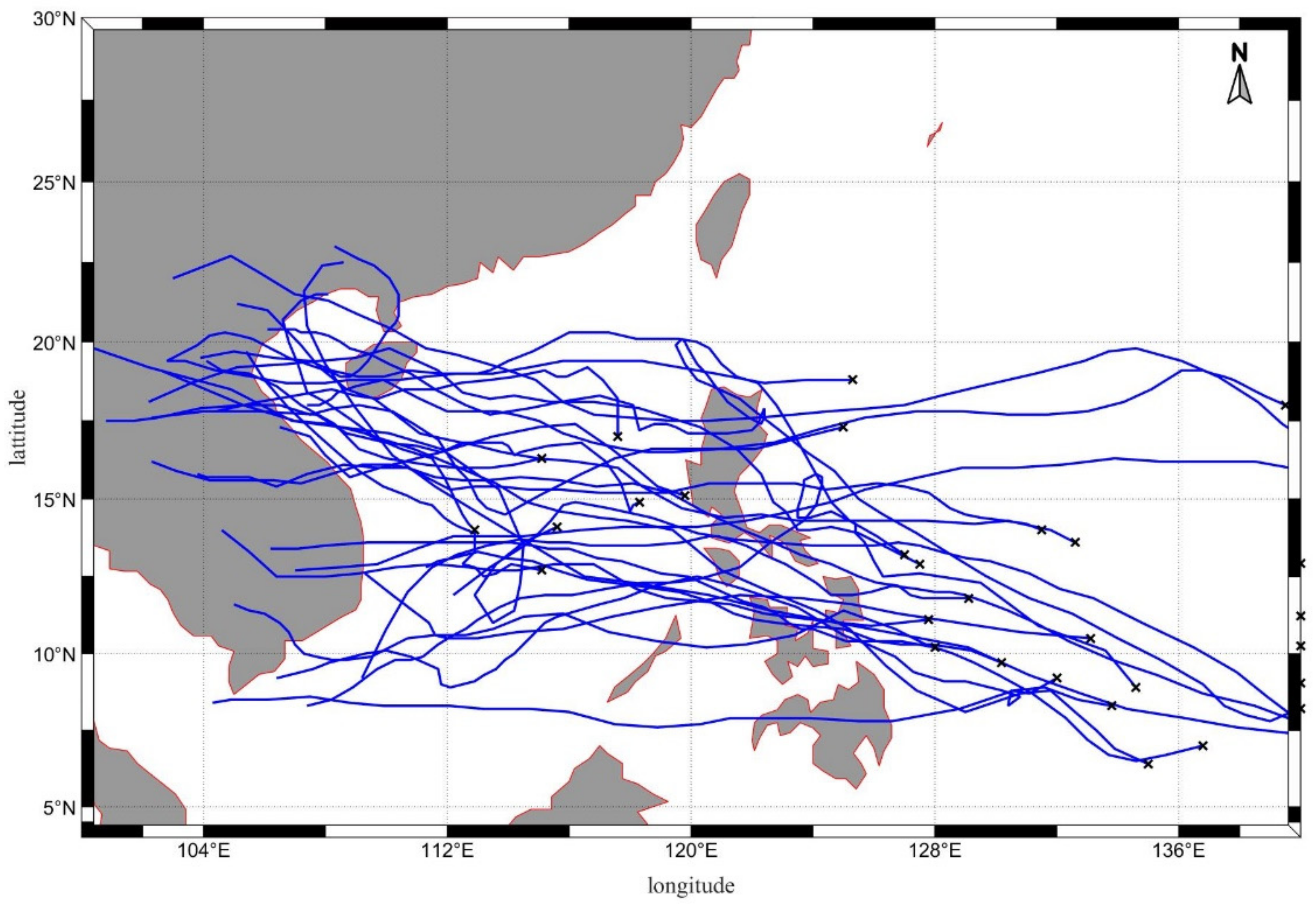
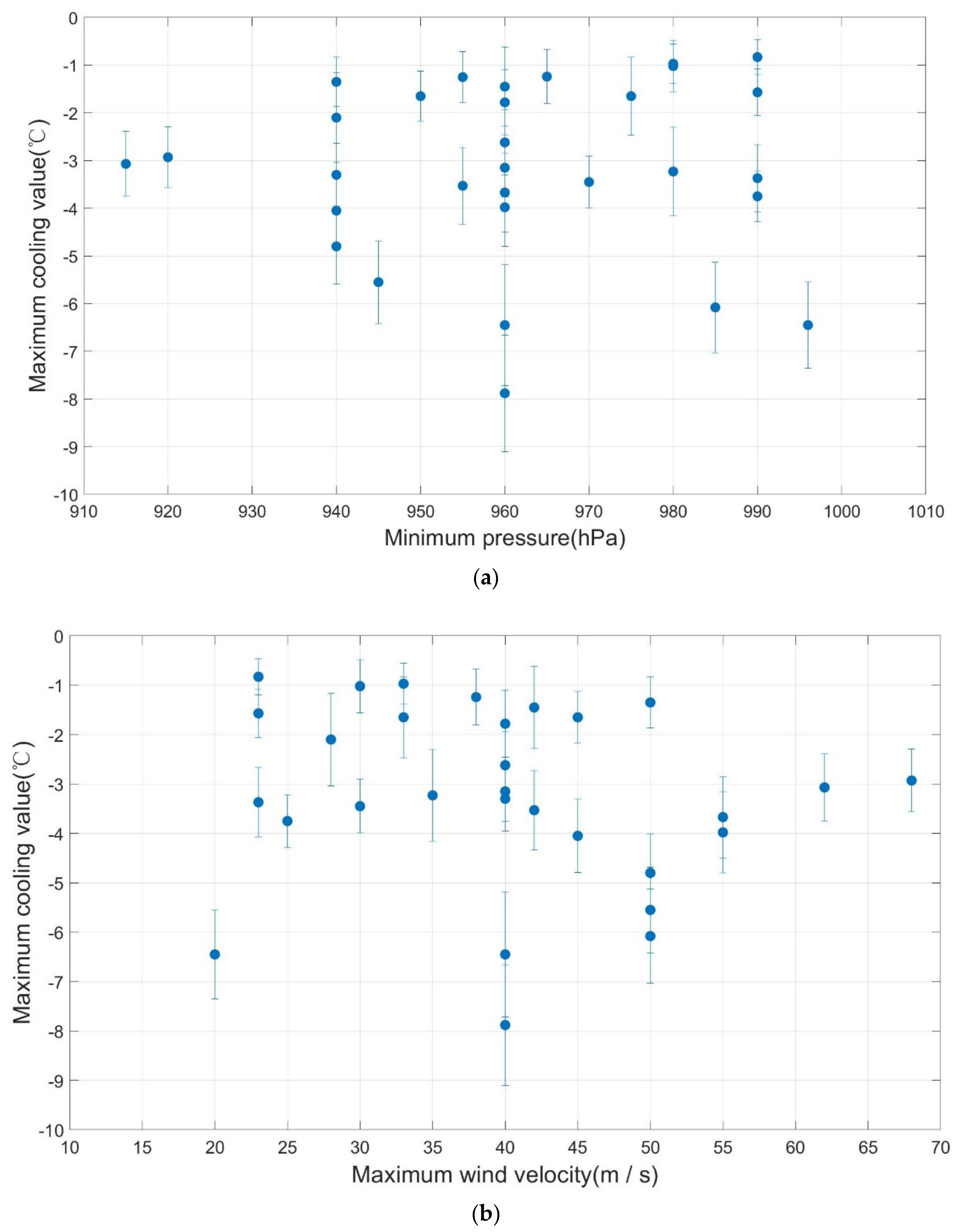

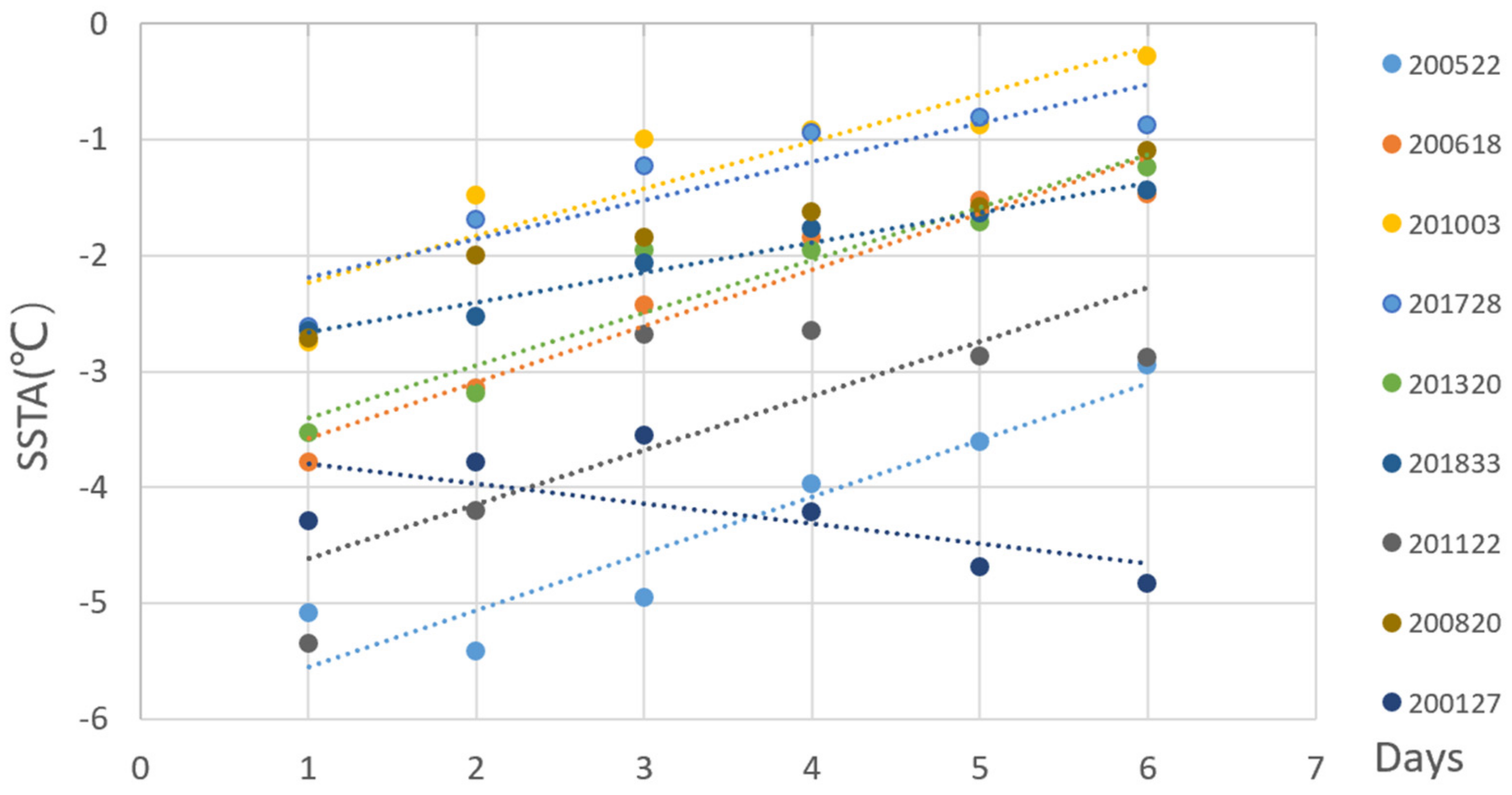
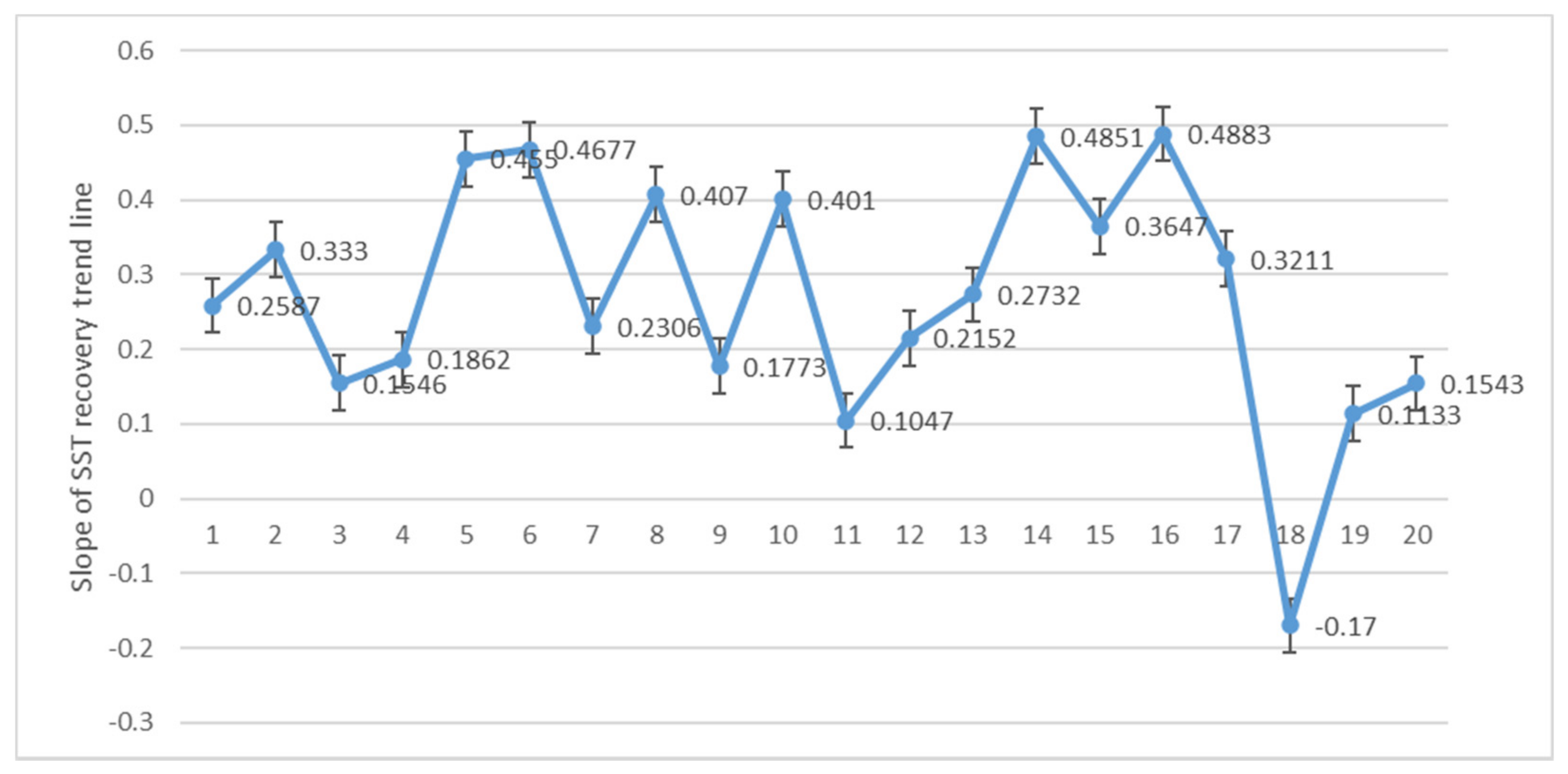

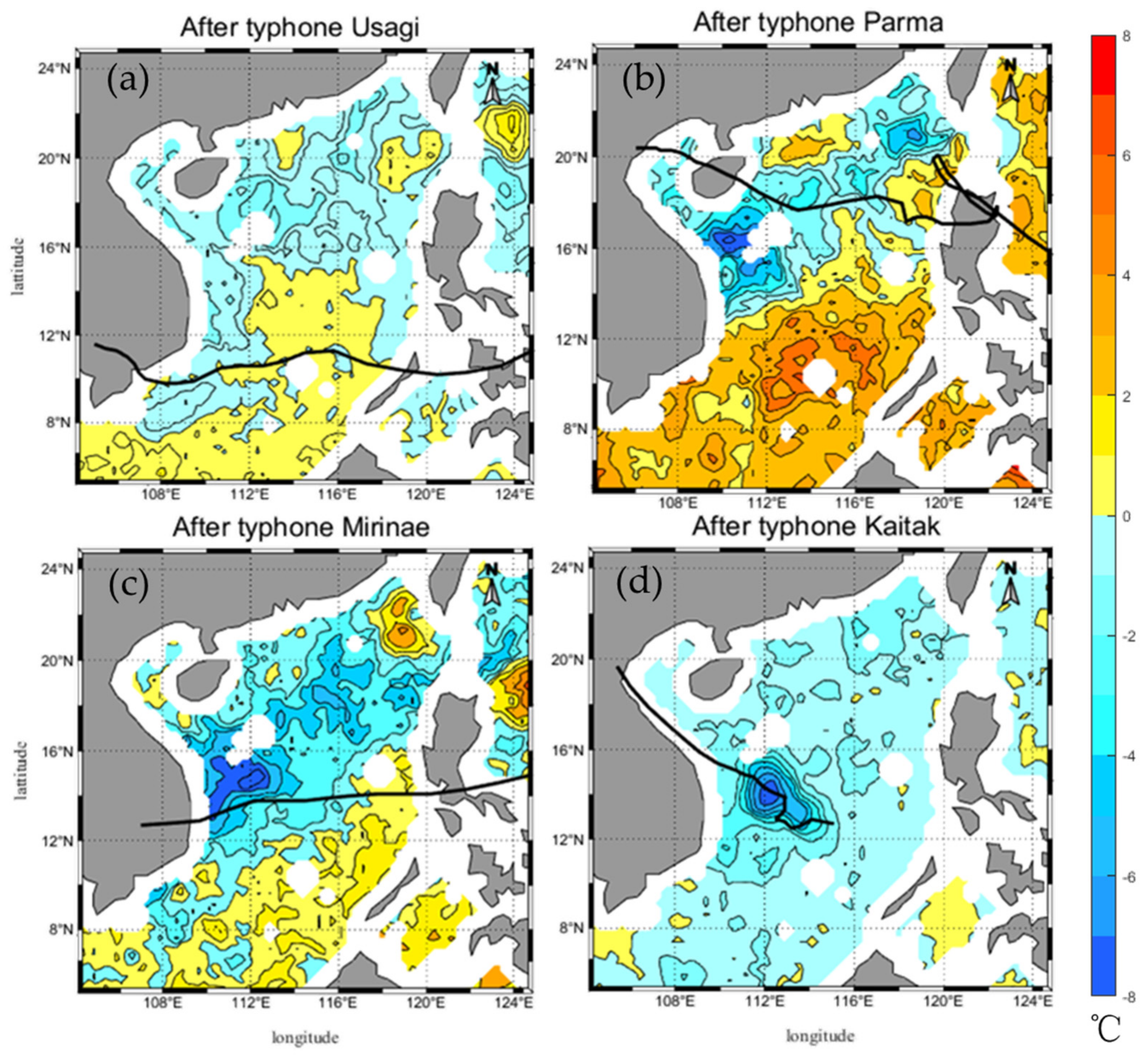

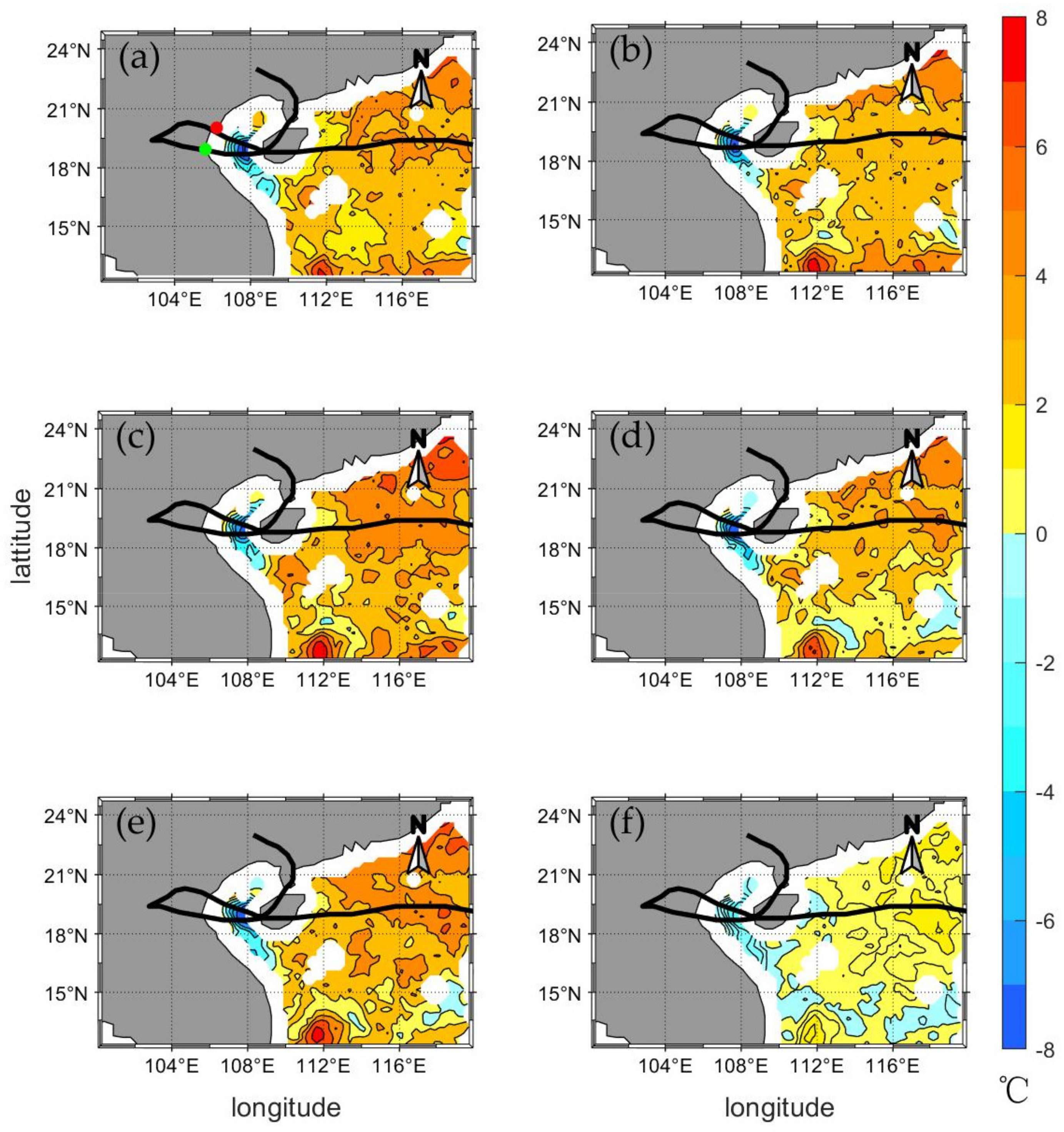
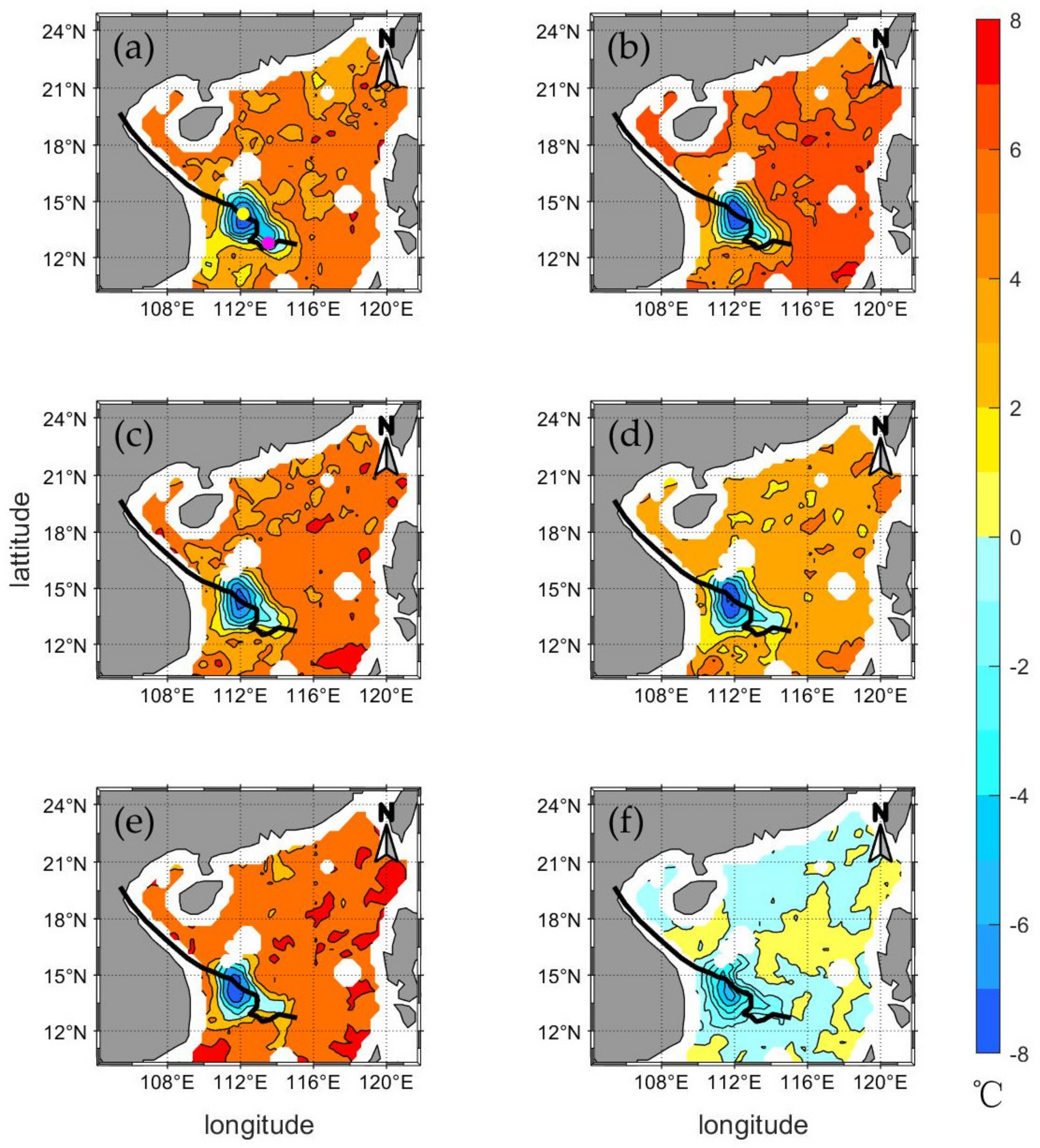
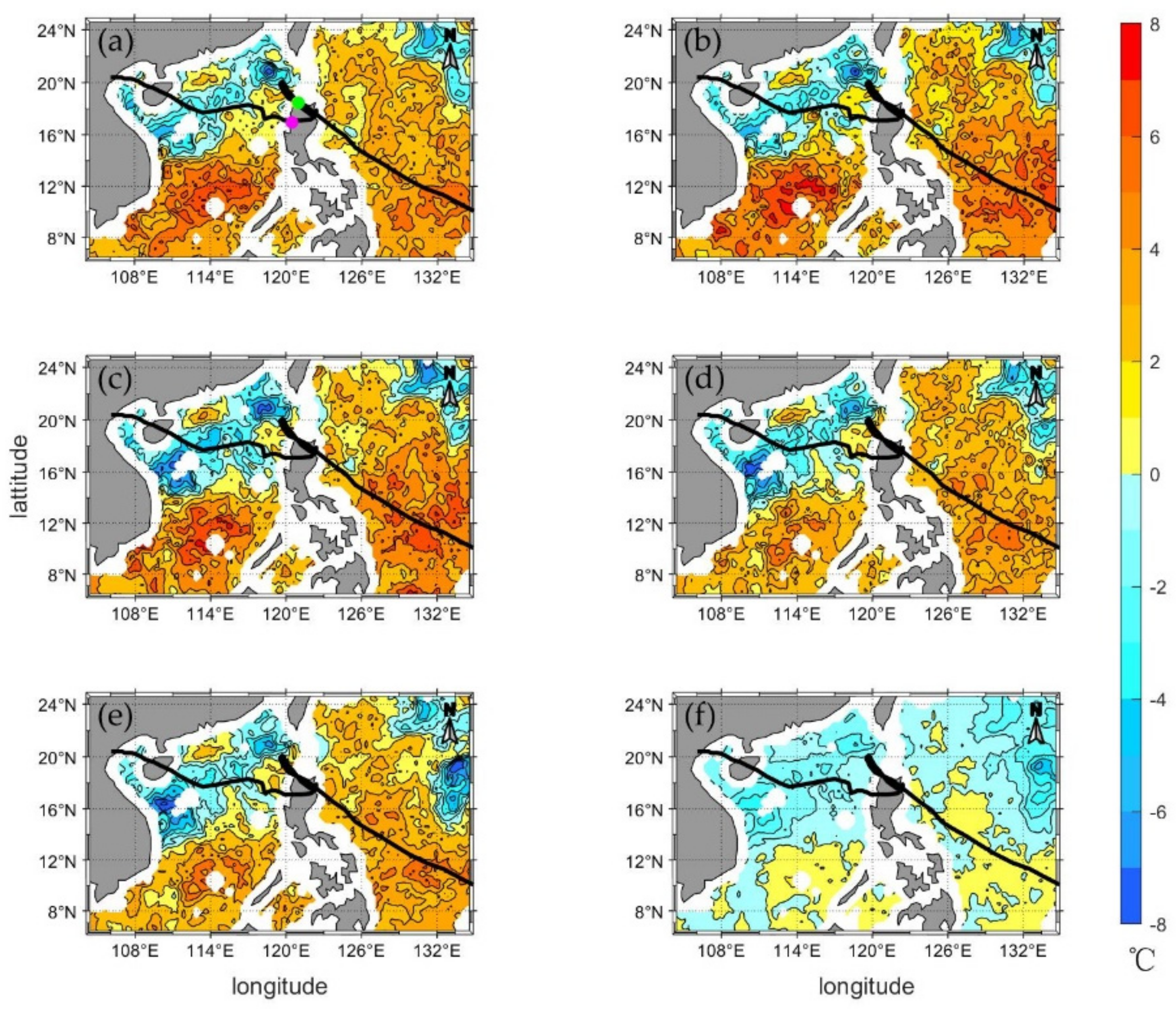
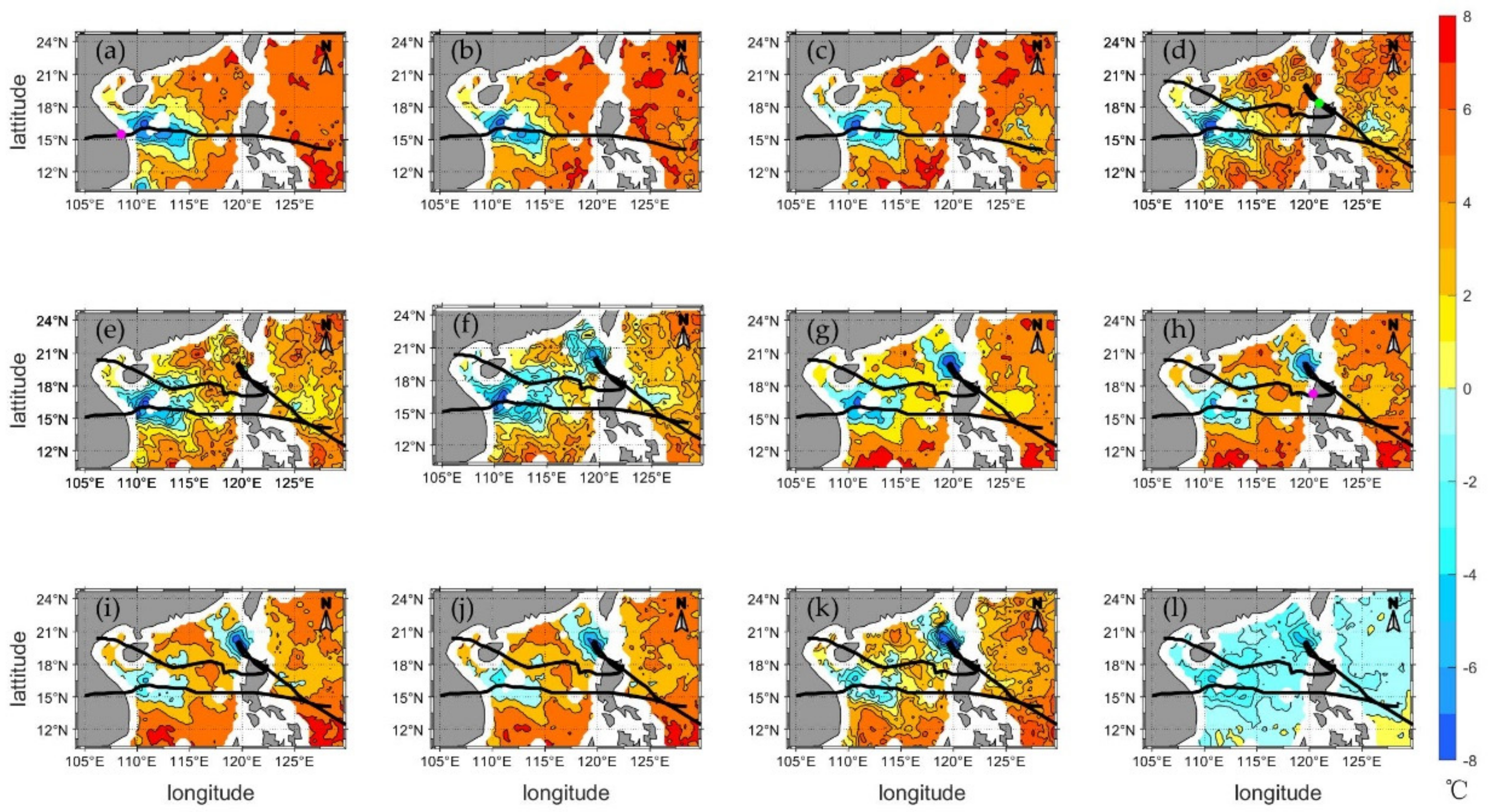
| Times | Names | Study Area | Typhoon Rank | Maximum Wind Velocity (m·s−1) |
|---|---|---|---|---|
| 1998/12 | Faith | 5°~25°N, 104°~125°E | STS | 30 |
| 1999/10 | Eve | 5°~25°N, 104°~125°E | TS | 23 |
| 2000/11 | Rumbia | 9°~9.5°N, 109°~110°E | TY | 40 |
| 2000/09 | Wukong | 19°~20°N, 115°~116°E | TS | 23 |
| 2001/12 | Kaijiki | 5°~25°N, 104°~125°E | TS | 20 |
| 2001/11 | Lingling | 13°~15°N, 113°~116°E | STY | 50 |
| 2003/08 | Krovanh | 18.5°~19.6°N, 114°~115°E | TY | 40 |
| 2004/11 | Muifa | 5°~25°N, 104°~125°E | TY | 40 |
| 2005/09 | Damrey | 19°~21°N, 112°~113°E | STY | 50 |
| 2005/10 | Kai-tak | 12.5°~15.1°N, 111°~113°E | TY | 40 |
| 2006/09 | Xangsane | 16°~17°N, 109°~111°E | STY | 50 |
| 2007/09 | Lekima | 5°~25°N, 104°~125°E | TY | 33 |
| 2008/09 | Mekkhala | 16.5°~17.5°N, 110°~111°E | TS | 23 |
| 2009/09 | Parma | 20°~22°N, 118°~120°E16°~17°N, 110°~111°E | Super TY | 55 |
| 2009/09 | Ketsana | 16°~17°N, 110°~111°E | TY | 40 |
| 2009/10 | Mirinae | 14°~15°N, 111°~113°E | TY | 40 |
| 2010/07 | Conson | 17.5°~18°N, 111.5°~112°E | TY | 35 |
| 2010/08 | Mindulle | 18°~19°N, 107°~108°E | STS | 30 |
| 2011/07 | Nockten | 18°~19°N, 111.5°~112.5°E | STS | 28 |
| 2011/09 | Nalgae | 17°~18.5°N, 115°~116°E | Super TY | 50 |
| 2012/10 | Son-tinh | 5°~25°N, 104°~125°E | STY | 45 |
| 2013/09 | Wutip | 18°~18.5°N, 112°~112.8°E | STY | 45 |
| 2013/10 | Nari | 5°~25°N, 104°~125°E | STY | 42 |
| 2013/11 | Haiyan | 5°~25°N, 104°~125°E | Super TY | 78 |
| 2014/12 | Hagutip | 15°~16°N, 115°~116°E | Super TY | 68 |
| 2016/12 | Nock-ten | 16.5°~18°N, 117°~119°E | Super TY | 62 |
| 2017/11 | Damrey | 13°~14.3°N, 113°~114°E | STY | 42 |
| 2017/12 | Tembin | 5°~25°N, 104°~125°E | TY | 38 |
| 2018/07 | Son-tinh | 18°~19°N, 107°~108°E | TS | 25 |
| 2018/11 | Usagi | 5°~25°N, 104°~125°E | TY | 33 |
| Typhoon Number | Names | Minimum Pressure (hPa) | Maximum Wind Velocity (m·s−1) | Cooling Position 1 | Maximum Cooling Value (°C) | Standard Deviation |
|---|---|---|---|---|---|---|
| 199824 | Faith | 980 | 30 | --- | 1.02 | 0.5377 |
| 199927 | Eve | 990 | 23 | --- | 0.83 | 0.3626 |
| 200023 | Wukong | 960 | 40 | Right | 2.62 | 0.6850 |
| 200033 | Rumbia | 990 | 23 | Right | 1.57 | 0.4895 |
| 200127 | Lingling | 996 | 20 | Right | 6.45 | 0.9031 |
| 200130 | Kaijiki | 940 | 50 | --- | 1.35 | 0.5147 |
| 200312 | Krovanh | 960 | 40 | Right | 3.15 | 0.6067 |
| 200439 | Muifa | 960 | 40 | --- | 1.78 | 0.6786 |
| 200517 | Damrey | 940 | 50 | Right | 4.80 | 0.7916 |
| 200522 | Kai-tak | 960 | 40 | Near | 7.88 | 1.2216 |
| 200618 | Xangsane | 945 | 50 | Right | 5.55 | 0.8689 |
| 200716 | Lekima | 975 | 33 | --- | 1.65 | 0.8208 |
| 200820 | Mekkhala | 990 | 23 | Right | 3.37 | 0.7045 |
| 200919 | Parma | 960 | 55 | Left Right | 3.67 3.98 | 0.8230 0.8230 |
| 200917 | Ketsana | 960 | 40 | Right | 6.45 | 1.2693 |
| 200923 | Mirinae | 940 | 40 | Right | 3.30 | 0.6582 |
| 201003 | Conson | 980 | 35 | Right | 3.23 | 0.9266 |
| 201006 | Mindulle | 970 | 30 | Right | 3.45 | 0.5437 |
| 201110 | Nockten | 940 | 28 | Right | 2.10 | 0.9369 |
| 201122 | Nalgae | 985 | 50 | Right | 6.08 | 0.9512 |
| 201224 | Son-tinh | 950 | 45 | --- | 1.65 | 0.5289 |
| 201320 | Wutip | 940 | 45 | Right | 4.05 | 0.7445 |
| 201324 | Nari | 960 | 42 | --- | 1.45 | 0.8336 |
| 201331 | Haiyan | 955 | 78 | --- | 1.25 | 0.5308 |
| 201422 | Hagutip | 920 | 68 | Right | 2.93 | 0.6367 |
| 201630 | Nock-ten | 915 | 62 | Right | 3.07 | 0.6837 |
| 201728 | Damrey | 955 | 42 | Right | 3.53 | 0.8039 |
| 201733 | Tembin | 965 | 38 | --- | 1.24 | 0.5658 |
| 201811 | Son-tinh | 990 | 25 | Near | 3.75 | 0.5311 |
| 201833 | Usagi | 980 | 33 | --- | 0.97 | 0.4177 |
Publisher’s Note: MDPI stays neutral with regard to jurisdictional claims in published maps and institutional affiliations. |
© 2021 by the authors. Licensee MDPI, Basel, Switzerland. This article is an open access article distributed under the terms and conditions of the Creative Commons Attribution (CC BY) license (http://creativecommons.org/licenses/by/4.0/).
Share and Cite
Ma, Z.; Zhang, Y.; Wu, R.; Na, R. Statistical Characteristics of the Response of Sea Surface Temperatures to Westward Typhoons in the South China Sea. Remote Sens. 2021, 13, 916. https://doi.org/10.3390/rs13050916
Ma Z, Zhang Y, Wu R, Na R. Statistical Characteristics of the Response of Sea Surface Temperatures to Westward Typhoons in the South China Sea. Remote Sensing. 2021; 13(5):916. https://doi.org/10.3390/rs13050916
Chicago/Turabian StyleMa, Zhaoyue, Yuanzhi Zhang, Renhao Wu, and Rong Na. 2021. "Statistical Characteristics of the Response of Sea Surface Temperatures to Westward Typhoons in the South China Sea" Remote Sensing 13, no. 5: 916. https://doi.org/10.3390/rs13050916
APA StyleMa, Z., Zhang, Y., Wu, R., & Na, R. (2021). Statistical Characteristics of the Response of Sea Surface Temperatures to Westward Typhoons in the South China Sea. Remote Sensing, 13(5), 916. https://doi.org/10.3390/rs13050916







